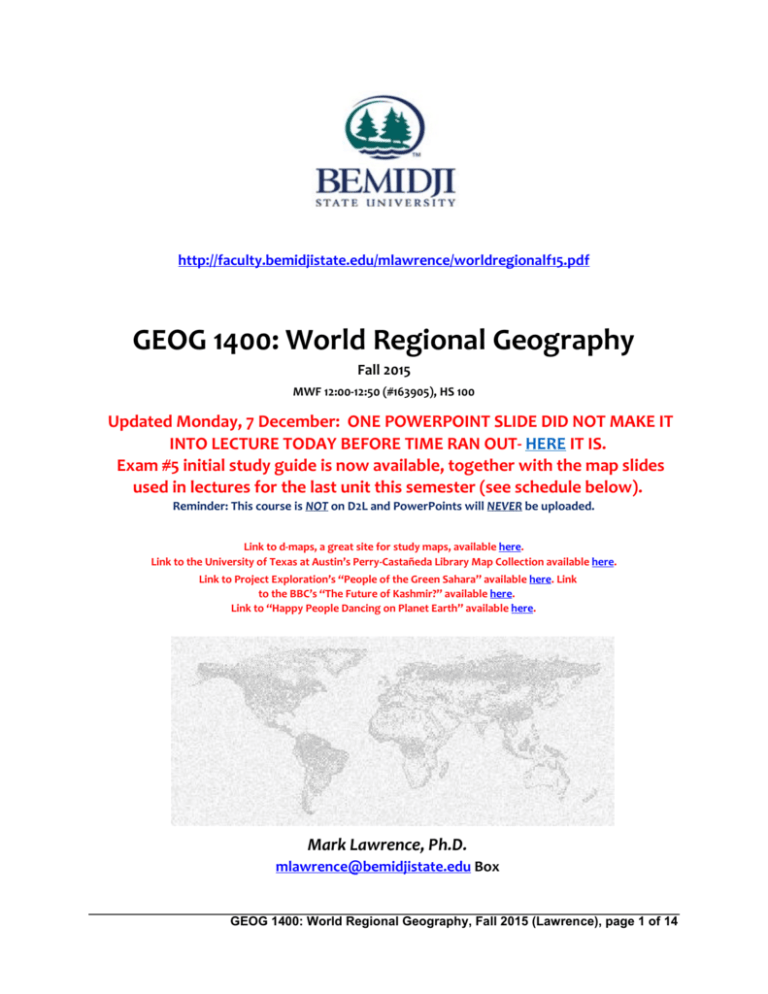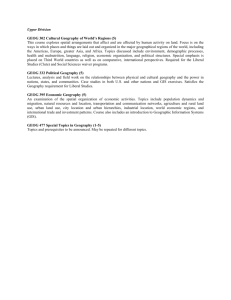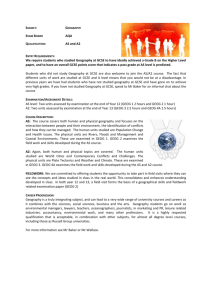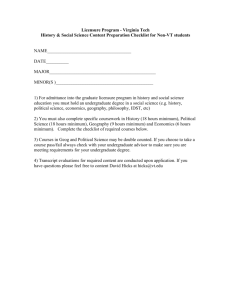World Regional Geography, Fall 2015
advertisement

http://faculty.bemidjistate.edu/mlawrence/worldregionalf15.pdf
GEOG 1400: World Regional Geography
Fall 2015
MWF 12:00-12:50 (#163905), HS 100
Updated Monday, 7 December: ONE POWERPOINT SLIDE DID NOT MAKE IT
INTO LECTURE TODAY BEFORE TIME RAN OUT- HERE IT IS.
Exam #5 initial study guide is now available, together with the map slides
used in lectures for the last unit this semester (see schedule below).
Reminder: This course is NOT on D2L and PowerPoints will NEVER be uploaded.
Link to d-maps, a great site for study maps, available here.
Link to the University of Texas at Austin’s Perry-Castañeda Library Map Collection available here.
Link to Project Exploration’s “People of the Green Sahara” available here. Link
to the BBC’s “The Future of Kashmir?” available here.
Link to “Happy People Dancing on Planet Earth” available here.
Mark Lawrence, Ph.D.
mlawrence@bemidjistate.edu Box
GEOG 1400: World Regional Geography, Fall 2015 (Lawrence), page 1 of 14
23, 239 Hagg-Sauer Hall
Office hours: Mondays, Wednesdays, and Fridays from 10:00 – 11:30 and 13:00 – 14:00;
Tuesdays and Thursdays from 11:00 –12:00.
Geography, sir, is ruinous in its effects on the lower classes. Reading, writing and arithmetic are comparatively
safe, but geography invariably leads to revolution.
Testimony to the House of Commons, 1879
This world, where much is to be done, and little known....
Samuel Johnson
Description and Rationale: Geographers study the spatial structures and behaviors involved in
human relations with the world; not merely where things are, but why and what difference it makes.
Through explorations of economic, political, cultural, and human geography, this course will
introduce you to many of the world’s regions in order to examine the tensions between ongoing
processes of “globalization” and renewed emphasis on local issues shaping the early 21st Century.
Course Objectives: By means of lecture and examination, students in this course are expected to
develop and refine skills and understanding in the following areas:
1.
Identification of key locations on maps of specific world regions.
2. Understanding and analysis of information presented in thematic maps.
3. Construction and interpretation of population pyramids based on demographic data
supplied for countries under investigation.
4. Understanding of the Demographic Transition Model and analysis of the position of
different national populations within it.
5. Understanding and analysis of Gross National Product and Human Development
Index data for various countries.
6. Understanding the political, economic, and human geographic characteristics of
three historical periods (the colonial era, the period of the Cold War, and the
postCold War era).
7. Definition of the terms supranationalism and devolution and analysis of their
application to study of differences between world regions.
8. Understanding of the environmental consequences of poverty and of different
approaches to development in various world regions.
GEOG 1400: World Regional Geography, Fall 2015 (Lawrence), page 2 of 14
Please note: Upon request this document can be made available in alternate formats. Please contact Dr. Lawrence or the
TRIO Student Support Services Office at 755-2614 (Sattgast 207). Please contact the TRIO Student Support Services Office
ONLY if you have a need for accommodations in this class. All other contact should be with your instructor only.
Requirements: 1000 points total
5 Exams (200 points each)
BE ADVISED THAT THIS IS A UNIVERSITY – LEVEL GEOGRAPHY COURSE, SO NO EXTRA
CREDIT WILL BE AVAILABLE THIS SEMESTER APART FROM THAT WHICH
MIGHT APPEAR IN EXAMS. LEARNING IS EXERCISE, AND THE HEALTHIEST FORM
THEREOF, SO THERE IS NO SUCH THING AS AN “EASY” COURSE OF STUDY.
Exams will be closed-book and will consist of {a} multiple-choice, {b} completion questions, and {c}
map-identification questions. Multiple-choice questions will primarily cover lecture material, with a
few rehearsing textbook material not covered in lectures but relevant to the unit involved in any
given exam. Completion questions will primarily cover the additional readings assigned for a given
unit available at the class website. Finally, some of the map-identification questions will be of the
multiple-choice variety, while some will be of the completion variety.
Each exam is worth up to 200 points and covers only material presented in reading
assignments and lectures (including any videos shown) since the previous exam date. Besides
general topical questions, you will be examined with regard to certain countries, listed on
GEOG 1400: World Regional Geography, Fall 2015 (Lawrence), page 3 of 14
prep sheets for each exam (including sample questions, with answers) that will be posted
online about a week before the exam.
Any exam that must be taken late {a} requires the instructor’s permission in advance, {b} will
not be offered more than three days (NOT class periods) after the scheduled period, and {c}
automatically involves a 20% reduction in score if one or two days late, but a 50% reduction if
taken three days late.
An important note: This is a university-level lecture course, and as such the exams will largely cover
lecture material (i.e., roughly one fourth to one third will be derived from the textbook). Some extra
credit might be included on exams, but don’t ask me for other extra credit opportunities, please.
Needless to say, failure to attend (or leaving early, listening to your tunes, fiddling with your cell
phone, sleeping, etc.) can only severely weaken your chances of passing exams. Likewise, having
conversations while I’m trying to lecture is both distracting for me and disrespectful of your fellow
students. I reserve the right to dismiss from class and reduce the course grade of any student who
chooses not to learn and/or to interfere with the learning of others.
The grading scale for the course will not be “curved” and is as follows:
A
90% (900+ points)
B
80% (800-899 points)
C
70% (700-799 points)
D
60% (600-699 points)
F
0-59% (500-599 points)
GEOG 1400: World Regional Geography, Fall 2015 (Lawrence), page 4 of 14
REQUIRED TEXT:
Hobbs, J.J. (2009) World Regional
Geography, Brooks/Cole CENGAGE Learning,
ISBN 0-495-38950-1, 6th edition.
We will NOT read the book in its published
chapter order, nor will we read Chapter 11 or
Module 11.2.
Make sure you have the 6th edition of the
book.
We will also be watching a number of video
programs in class.
Additional assigned readings are available at
the course website.
REMINDER: I reserve the right to dismiss from class and reduce the course grade of any
student sleeping, texting, listening to music or radio, or otherwise disrupting the
educational opportunities of others. As this is a university course, you should respect this
space and time for learning and yourselves as learners.
A Compass of World Regions
(subject to change- check the syllabus online regularly)
GEOG 1400: World Regional Geography, Fall 2015 (Lawrence), page 5 of 14
Al-Samt:
Africa and the Ummah
(24 August – 16 September)
GEOG 1400: World Regional Geography, Fall 2015 (Lawrence), page 6 of 14
We begin this semester in Africa and end in the Pacific and at the poles; after all, Africa is our mother
continent, the Pacific and the poles the last regions to be settled by humankind. Taken together, they are
today incredibly important open-air laboratories for the most significant experiment in human history- can we
survive our own ability to radically reshape, consume, and discard Earth’s resources? At least 80% of the
world’s supply of coltan is found in the equatorial rainforests of Africa, a compound essential to the
production of the high-end electronics upon which so many of us have become completely dependent.
Likewise, a compound discovered in the soil of remote Rapa Nui (“Easter Island”) in the southeast Pacific
Ocean could extend lifespan by more than 25 years.
Between here and there, the curve of the Earth can disorient, and professional Geography is much more than
simply memorization of locations. After all, to be located at all is to have a sense of orientation, an awareness
of your immediate horizons and therefore of the possibilities of movement. The word “azimuth” used by
cartographers, engineers, military personnel and others to describe direction from one location toward
another is a corruption of the Arabic al-sumūt, the plural of al-samt, meaning “the way”.
This is a reminder, of course, that despite our unjustifiably deeply rooted bias, we in the so-called West owe an
immense debt of history to the cultures of the Middle East through which our earliest human ancestors passed
on their way out of Africa to people the planet. After all, human beings built permanent settlements for the
first time more than 12,000 years ago in the Wadi an-Natuf in what is now the West Bank of Palestine illegally
occupied by Israel. The Natufian culture eventually domesticated animals and plants, established markets, and
generally gave rise to the world’s first civilizations. The Middle East became the cradle of the world’s three
largest monotheistic religions (Judaism, Christianity, and Islam), and when Europe plunged into the Dark Ages
it was Muslim scholars of the Ummah stretching from southern Spain to western China and from Central Asia
to East Africa who maintained and expanded upon Greek and Roman knowledge of the universe. Further east,
the Ummah connected to the Silk Road and the vast empires of the Mongols. This semester, we begin our
course by taking our bearings from the center of human history, today no less than millennia ago in Africa and
the Wadi an-Natuf.
Textbook reading:
Skim chapter 1, and in order read all of chapter 9, Module 9.1, chapter 6, Module 6.1, and
Module 5.1.6.
Additional reading:
Akwagyiram, A. (2013) “Africa rising- but who benefits?”, BBC News-Africa.
El Sherif, A. (2011) “Islamism after the Arab Spring”, Current History 110:358+.
Symmes, P. (2013) “A wild country grows in South Sudan”, Outside Magazine, May.
Wehrey, F. (2011) “Uprisings jolt the Saudi-Iranian Rivalry”, Current History, December: 352
– 357.
Williamson, R.S. (2011) “Sudan on the cusp”, Current History, (May):171 – 176.
GEOG 1400: World Regional Geography, Fall 2015 (Lawrence), page 7 of 14
“Southern Treasures”
Monday, 7 September
No class
[CHANGED DATE] Wednesday, 16
September
Exam #1
Study maps available
here.
The Easts:
East, South, and Southeast Asia
(18 September – 12 October)
GEOG 1400: World Regional Geography, Fall 2015 (Lawrence), page 8 of 14
When asked once what he thought of Western civilization, India’s Mahatma (“Great Soul”) Ghandi said that
he thought it would be a very good idea. Indeed, it is only very recently- and arguably it will be only very
briefly- that the cultures of the Euro-American “Wests” have dominated the planet. By contrast, it is the
Asian “Easts” that have exerted the greatest gravitational pull on human history- Colombus risked crossing
the dangerous waters of the North Atlantic not to reach North America but in search of China, as did the
Portuguese before him mastering the long coasts of Africa and Magellan after him crossing the vastness of
the Pacific. Paper, the magnetized compass, gunpowder, and printing- these and many other inventions
essential to the creation of our modern world all originated in China. Meanwhile, as the birthplace of
Hinduism and Buddhism, as well as the site of one of the first Christian communities, India today hosts the
world’s largest democracy, and while Islam started in the Middle East, Indonesia in Southeast Asia has the
largest contemporary Muslim population. Collectively, India and China today are home to almost one third of
the human race, and both are making more progress than any Western country or group of countries in
reestablishing a human presence on the Moon while also reaching for Mars. For these and so many other
reasons, the “Easts” continue to be the focal point for the future of the planet.
Textbook reading:
Read in order all of chapter 7 and Modules 7.3, 7.4, 7.1, and 7.2
Additional reading:
Brooks, K. (2011) “Is Indonesia bound for the BRICs?” Foreign Affairs.
French, H. (2007) “Far from Beijing’s reach, officials bend energy rules”, Part V
of the series “Choking on Growth”, The New York Times.
Gluckman, R. (2011) “Welcome to Minegolia: How the land of Genghis Khan
became a new Gold Rush San Francisco on the steppe”, Foreign Policy 184.
Larkin, E. (2012) “The Awakening”, The New Republic, 2 February, 4-16.
“A Passage to India”
GEOG 1400: World Regional Geography, Fall 2015 (Lawrence), page 9 of 14
Monday, 12 October
Exam #2
Study maps available
here.
The Wests:
Europe and Russia
(14 October – 9 November)
The 30 Years’ War, the 100 Years’ War, the Napoleonic Campaigns, World War One, World War Two, the Cold
War…. For all our celebration of our European heritage, the history of the “West” is arguably the most
violent and repressive of all regional histories. To be sure, the world created by European colonialism in the
19th Century- and policed by American superpower military actions in the 20th Century- was technologically
superior to anything ever seen before, but it depended on invasion of virtually every other part of the globe
and the sacrifice of millions of lives at home to support the ambitions of the Spanish, the French, the British,
and German empires among others. Our own American story depends on millions more fleeing from the
violence of Europe to settle new lands, and of course we repeated many of the same tragedies here and
continue to treat one another irresponsibly. Today, the age of colonialism is said to be finished, and even the
U.S. superpower is much diminished as new, non-Western powers challenge us for world leadership. But the
regional imprint of the West is a lasting one, exceeding the boundaries of the European subcontinent as
postSoviet Russia once again struggles to define itself in terms of mezhdu razvivatsya, finding its future in
between worlds.
GEOG 1400: World Regional Geography, Fall 2015 (Lawrence), page 10 of 14
Textbook reading:
Read in order all of chapter 4, Modules 4.1 and 4.2, chapter 5, and Modules 5.1.1, 5.1.2, 5.1.3,
and 5.1.5
Additional reading:
Cottrell, R. (2005) “Meet the neighbours: A survey of the EU’s eastern
borders”, The Economist, 25 June.
Farago, J. (2013) “Croatia joins the EU and cultural barriers fall”, New Republic,
3 July.
“Wild Europe: A New Millennium”
Friday, 16 October
Monday, 9 November
No meeting for this
class
Exam #3
Study maps available
here.
GEOG 1400: World Regional Geography, Fall 2015 (Lawrence), page 11 of 14
The Souths:
The other New Worlds: Latin America & the Caribbean
(11 – 20 November)
The brutal truth is that the ferocious history of the “Wests”, including the spectacular abundance of the
Industrial Revolution and the presumption of a liberating democracy, depended on massive exploitation of
peoples, places, and their resources that still have not been given the same opportunities to succeed. For
Europeans intent on mastering passage to- and, later, control of- the “Easts”, the demographic crash of Native
American populations from the Arctic to Tierra del Fuego necessitated the repopulating of much of the socalled New World. Where “white” labor was scarce and expensive, importation of enslaved Africans
fundamentally altered the cultural geography of the Western Hemisphere. Later, the power of crushing debt
was coupled with racism to import Southeast Asians into parts of so-called “Latin America” as well. In terms
of demographics today, Mexico’s Yucatan, Brazil’s Amazon and northeast, and virtually all of Belize, Bolivia,
Ecuador, Guatemala, and Peru are non-“white” and therefore arguably less part of the “Wests” than they are
of the “Souths”.
Textbook reading:
Read in order all of chapter 10 and Modules 10.2 and 10.1
Additional reading:
Farnsworth, E. (2011) “The New Mercantilism: China’s emerging role in the Americas”,
Current History, (February):56 – 61.
Hammer, J. (2013) “A look into Brazil’s makeover of Rio’s slums”, Smithsonian Magazine,
January.
Looney, R. (2013) “Finally, good news from Haiti”, Foreign Policy, 3 May.
Sontag, D. (2012) “Rebuilding in Haiti lags after billions in post-quake aid”, New York Times,
23 December.
GEOG 1400: World Regional Geography, Fall 2015 (Lawrence), page 12 of 14
Wednesday, 11 November
No classes
Friday, 20 November
Exam #4
Study maps available
here.
The next frontiers:
The Pacific and the poles
(30
November – 7 December)
At the Equator, the Earth spins on its axis at a speed of more than 1,000 miles per hour while racing around
the Sun at nearly 67,000 miles per hour. With satellite telecommunications, it can feel as though the news of
the day moves even faster, email and cell phones virtually transporting us around the globe and back again in
just seconds. For that matter, even the continents don’t sit still, sliding across the planet’s ever-active volcanic
interior. No wonder the study of world regional geography can leave you dizzy. Under the circumstances, it
should come as no surprise that as regional identities change, some search for stability at any cost. Today,
probably the most significant developments of this sort are simultaneously far away but close at hand, only
until recently out of view for most of us but now increasingly unavoidable. The vast Pacific Ocean covers fully
one third of the globe, the last region to be settled by humankind, but like Africa it is today an incredibly
important open-air laboratory for the most significant experiment in human history: can we survive our own
ability to radically reshape, consume, and discard Earth’s resources? This is even more than the case with
Antarctica, which like today’s Arctic region is no longer what it once was.
GEOG 1400: World Regional Geography, Fall 2015 (Lawrence), page 13 of 14
Textbook reading:
Read in order all of chapter 8, Module 8.1, Module 11.1.6, Module 11.1.7, and Module 5.1.4
Additional reading:
Krauss, C. et alia (2005) “The Big Melt: As polar ice turns to water, dreams of
treasure abound”, New York Times, 20 October.
Myers, S.L. et alia (2005) “The Big Melt: Old ways of life are fading as the Arctic
thaws”, New York Times, 20 October.
n.a. (2013) “The Pacific’s colonies: Ends of empire”, The Economist.
Siegel, M. (2012) “A tiny Pacific Island nation that does not smell like Paradise”,
New York Times, 23 October: A7.
Monday through Friday, 23 – 27
November
10:30 – 12:30 Wednesday, 16
December
[NOTE THAT THIS EXAM MEETS AT A TIME DIFFERENT
THAN OUR USUAL CLASS PERIOD]
No classes
Exam #5
Study maps available
here.
GEOG 1400: World Regional Geography, Fall 2015 (Lawrence), page 14 of 14








